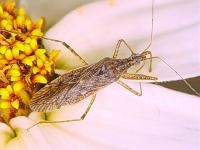Common name: Nabids
Scientific name:
Nabis ferus, N. aternatus, N. capsiformis
Hemiptera:Nabidae
Type
Generalist predator
Hosts
Aphids, armyworms, asparagus beetle, Colorado potato beetle eggs and nymphs, corn earworm, corn borer, imported cabbageworm, leafhoppers, mites, moth eggs, sawfly larvae, and tarnished plant bug nymphs. Although they can survive for about two weeks without food, they will eat each other if no other prey is available.
Description
Eggs are deposited in soft plant tissues where they are so
difficult to find.
Nymphs resemble adults and develop through 5 nymphal stages in about 50 days.
Adults are tiny, about 2-4 mm long, with slender bodies and are yellowish or gray or reddish-brown in color. They have piercing-sucking mouthparts, a 4-segmented beak, elongated heads, and 4 long segmented antennae. They are fast runners with long slender back legs and enlarged forelegs for grasping prey. They are commonly found in most agricultural crops, especially legumes, throughout the year. Adults begin laying eggs soon after emergence.
Conservation
They prefer to live in soybeans, grassy fields, and alfalfa. You can collect damsel bugs in alfalfa fields and release them around your garden.
External links
References
- Ellis, B.; Bradley, F. (1996): The organic gardener's handbook of natural insect and disease control. Rodale Press. Emmaus, Pennsylvania.
- Teetes, G.; Pendleton, B. (1999): Insect pests of sorghum. Department of Entomology. Texas A&M University.
- Yepsen, R. Editor. (1984): The encyclopedia of natural insect and disease control. Rodale Press, Emmaus, PA.

